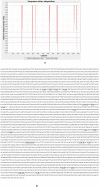Multi-epitopes vaccine design for surface glycoprotein against SARS-CoV-2 using immunoinformatic approach
- PMID: 38298616
- PMCID: PMC10827691
- DOI: 10.1016/j.heliyon.2024.e24186
Multi-epitopes vaccine design for surface glycoprotein against SARS-CoV-2 using immunoinformatic approach
Abstract
Background: The recent COVID vaccinations have successfully reduced death and severity but did not stop the transmission of viruses by the emerging SARS-CoV-2 strain. There is a need for better and long-lasting dynamic vaccines for numerous prevailing strains and the evolving SARS-CoV-2 virus, necessitating the development of broad-spectrum strains being used to stop infection by reducing the spread rate and re-infection. The spike (S) glycoprotein is one of the proteins expressed commonly in the early phases of SARS-CoV-2 infection. It has been identified as the most immunogenic protein of SARS-CoV-2.
Methods: In this study, advanced bioinformatics techniques have been exploited to design the novel multi-epitope vaccine using conserved S protein portions from widespread strains of SARS-CoV-2 to predict B cell and T cell epitopes. These epitopes were selected based on toxicity, antigenicity score and immunogenicity. Epitope combinations were used to construct the maximum potent multi-epitope construct with potential immunogenic features. EAAAK, AAY, and GPGPG were used as linkers to construct epitopes.
Results: The developed vaccine has shown positive results. After the chimeric vaccine construct was cloned into the PET28a (+) vector for expression screening in Escherichia coli, the potential expression of the construct was identified.
Conclusion: The construct vaccine performed well in computer-based immune response simulation and covered a variety of allelic populations. These computational results are more helpful for further analysis of our contract vaccine, which can finally help control and prevent SARS-CoV-2 infections worldwide.
Keywords: Antigenicity; B cell; Construct; Epitopes; Immune; Prediction; T cell; Vector.
© 2024 Published by Elsevier Ltd.
Conflict of interest statement
The authors declare that they have no known competing financial interests or personal relationships that could have appeared to influence the work reported in this paper.
Figures














Similar articles
-
Immunoinformatics Strategy to Develop a Novel Universal Multiple Epitope-Based COVID-19 Vaccine.Vaccines (Basel). 2023 Jun 12;11(6):1090. doi: 10.3390/vaccines11061090. Vaccines (Basel). 2023. PMID: 37376479 Free PMC article.
-
Design of a novel multiple epitope-based vaccine: An immunoinformatics approach to combat SARS-CoV-2 strains.J Infect Public Health. 2021 Jul;14(7):938-946. doi: 10.1016/j.jiph.2021.04.010. Epub 2021 May 4. J Infect Public Health. 2021. PMID: 34119848 Free PMC article.
-
Exploring the out of sight antigens of SARS-CoV-2 to design a candidate multi-epitope vaccine by utilizing immunoinformatics approaches.Vaccine. 2020 Nov 10;38(48):7612-7628. doi: 10.1016/j.vaccine.2020.10.016. Epub 2020 Oct 9. Vaccine. 2020. PMID: 33082015 Free PMC article.
-
Immunoinformatics approach to epitope-based vaccine design against the SARS-CoV-2 in Bangladeshi patients.J Genet Eng Biotechnol. 2022 Sep 20;20(1):136. doi: 10.1186/s43141-022-00410-8. J Genet Eng Biotechnol. 2022. PMID: 36125645 Free PMC article.
-
Identification of B-Cell Epitopes for Eliciting Neutralizing Antibodies against the SARS-CoV-2 Spike Protein through Bioinformatics and Monoclonal Antibody Targeting.Int J Mol Sci. 2022 Apr 14;23(8):4341. doi: 10.3390/ijms23084341. Int J Mol Sci. 2022. PMID: 35457159 Free PMC article. Review.
Cited by
-
Development of an Indirect Competitive ELISA Based on a Stable Epitope of β-Lactoglobulin for Its Detection in Hydrolyzed Formula Milk Powder.Foods. 2024 Oct 30;13(21):3477. doi: 10.3390/foods13213477. Foods. 2024. PMID: 39517261 Free PMC article.
-
Designing of a multiepitope-based vaccine against echinococcosis utilizing the potent Ag5 antigen: Immunoinformatics and simulation approaches.PLoS One. 2025 Feb 12;20(2):e0310510. doi: 10.1371/journal.pone.0310510. eCollection 2025. PLoS One. 2025. PMID: 39937717 Free PMC article.
-
Designing of a multi-epitopes based vaccine against Haemophilius parainfluenzae and its validation through integrated computational approaches.Front Immunol. 2024 Apr 16;15:1380732. doi: 10.3389/fimmu.2024.1380732. eCollection 2024. Front Immunol. 2024. PMID: 38690283 Free PMC article.
-
In silico design of a multi-epitope vaccine against Mycobacterium avium subspecies paratuberculosis.Front Immunol. 2025 Jan 28;16:1505313. doi: 10.3389/fimmu.2025.1505313. eCollection 2025. Front Immunol. 2025. PMID: 39935480 Free PMC article.
-
Exploring glutathione transferase and Cathepsin L-like proteinase for designing of epitopes-based vaccine against Fasciola hepatica by immunoinformatics and biophysics studies.Front Immunol. 2024 Sep 26;15:1478107. doi: 10.3389/fimmu.2024.1478107. eCollection 2024. Front Immunol. 2024. PMID: 39391319 Free PMC article.
References
-
- Al-Qahtani W.S., Alneghery L.M., Alqahtani A.Q.S., Alkahtani M.D., Alkahtani S. A review of comparison study between corona viruses (Sars-cov, mers-cov) and novel corona virus (COVID-19) Rev. Mex. Ing. Quim. 2020;19:201–212. doi: 10.24275/rmiq/Bio1692. - DOI
-
- Rabaan A.A., Al-Ahmed S.H., Haque S., Sah R., Tiwari R., Malik Y.S., Dhama K., Yatoo M.I., Bonilla-Aldana D.K., Rodriguez-Morales A.J. SARS-CoV-2, SARS-CoV, and MERS-CoV: a comparative overview. Infez. Med. 2020;28:174–184. - PubMed
LinkOut - more resources
Full Text Sources
Miscellaneous

